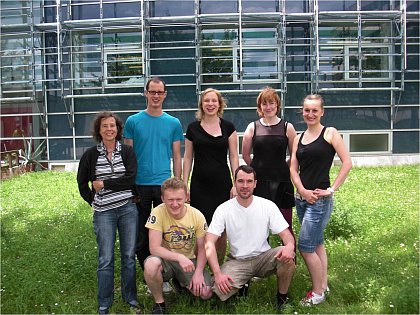Elisabeth Schwarz - Research Group: Recombinant Therapeutic Proteins
Kontakt
Elisabeth Schwarz
Raum 259
Kurt-Mothes-Str. 3
06120 Halle
Lab members

From left to right:
Elisabeth Schwarz, group leader; Steffen Damm, Ph.D. student; Tino Thieme, Ph.D. student; Silke Kuhfahl, Ph.D. student; Jens Liebold, Ph.D. student; Caroline Rast, master student; Karen Hertel, master student.
Not pictured:
Christiane Harnisch, technical assistant
Research Projects
Project 1 – The role(s) of Pro-Peptides in Human Bone Growth Factors
Silke Kuhfahl, Tino Thieme
Funded by the BMBF via Protein-Kompetenznetzwerk-Halle: „Tools, Targets & Therapeutics, and European Regional Development Fund (EFRE)
Human growth factors have an enormous therapeutic potential. Several of these proteins are in clinical use for years. We focus on two human growth factors, bone morphogenetic protein-2, BMP-2 and growth and differentiation factor-5, GDF-5. Both growth factors are synthesized in vivo as pre-pro-proteins. While the pre-sequences confer translocation into the secretory ER, the roles of the prodomains are to be identified. We could demonstrate that the prodomain of BMP-2 confers latency as the corresponding prodomain of TGF-b. This implicates that proforms could be used as retard forms. A functional subdomain within the prodomain of BMP-2 and GDF-5 has recently been identified and characterized. The project aims to obtain more information on the structure and function of BMP prodomains.
Selected Publications
Hillger, F., Herr, G., Rudolph, R. and Schwarz, E. (2005). Biophysical comparison of BMP-2, proBMP-2 and the free pro-peptide reveals stabilization of the pro-peptide by the mature growth factor. J. Biol. Chem., 280, 14974-14980.
Hauburger, A., von Einem, S., Schwärzer, G. K, Buttstedt, A., Zebisch, M., Schräml, M., Hortschansky, P., Knaus, P. and Schwarz, E. (2009). The pro-form of BMP-2 interferes with BMP-2 signaling by competing with BMP-2 for IA receptor binding. FEBS J., 276, 6386-6398.
von Einem, S., Schwarz, E. and Rudolph, R. (2010). A novel Two-Step renaturation procedure for efficient production of recombinant BMP-2. Prot. Expr. Purific., 73, 65-69.
Lochmann, A., Nitzsche, H., von Einem, S., Schwarz, E. and Mäder, K. (2010). The influence of covalently linked and free polyethylene glycol on the structural and release properties of rhBMP-2 loaded microspheres. J. Contr. Rel., 147, 92-100.
Buttstedt, A., Paoletti, F. and Schwarz, E. (2011). Wachstumsfaktoren der Cystin-Knoten-Familie und ihre Pro-Formen. Biospektrum, 17, 02, 150-153.
von Einem, S., Erler, S., Bigl, K., Frerich, B. and Schwarz, E. (2011). The pro-form of BMP-2 exhibits a delayed and reduced activity when compared to mature BMP-2. Growth Fact., 29, 63-71.
Kuhfahl, S., Hauburger, A., Thieme, T., Groppe, J., Ihling, C., Tomic, S., Schutkowski, M., Sinz A. and Schwarz, E. (2011). Identification of a core domain within the proregion of bone morphogenetic proteins that interacts with the dimeric, mature domain. Biochem. Biophys. Res. Comm., 408, 300-305.
Ebelt, H., Hillebrand, I., Arlt, S., Zhang, Y., Kubin, T., Kostin, S., Neuhaus, H., Müller-Werdan, U., Schwarz, E., Werdan, K. and Braun, T. (2013). BMP2 treatment limits infarct size after myocardial infarction in mice. Shock, 39, 353-360.
Rödel, E. K., Schwarz, E. and Kanse, S. (2013). The factor VII-activating protease (FSAP) enhances the activity of bone morphogenetic protein-2 (BMP-2). J. Biol. Chem., 288, 7193-7203.
Project 2 – Poly-Alanine Induced Fibril Formation
Jens Liebold, Steffen Damm
Funded by the GRK 1026 and European Regional Development Fund (EFRE)
Trinucleotide expansions in exon 1 for PABPN1 (nuclear poly(A) binding protein PABPN1) result in the disease Oculopharyngeal Muscular Dystrophy (OPMD). The trinucleotide expansions lead to an extension of a natural 10 alanine sequence in healthy individuals to maximal 7 additional alanines in patients with OPMD. Histochemical analyses of OPMD tissue samples revealed intranuclear fibrillar inclusions that mainly contained PABPN1.
The projects focus on the molecular processes by which the additional alanines lead to pathogenesis. In addition, the effect of alanines on protein stability and fibril formation is explored via fusions with model proteins which are structurally and thermodynamically well-characterized. Of major interest is the characterization of the kinetics of fibril formation, investigations of fibril structure(s) and the influence of a neighboured folded domain on fibril formation.
Selected Publications
Scheuermann, T., Schulz, B., Blume, A., Wahle, E., Rudolph, R. and Schwarz, E. (2003). Trinucleotide expansions leading to an extended poly-L-alanine segment in the poly (A) binding protein PABPN1 cause fibril formation. Prot. Sci., 12, 2685-2692.
Lodderstedt, G., Hess, S., Hause, G., Scheibel, T. and Schwarz, E. (2007). The number of alanines in the N-terminal domain of the poly (A) binding protein PABPN1 dictates fibril growth, morphology and stability. FEBS J., 274, 346-355.
Lodderstedt, G., Sachs, R., Faust, J., Bordusa, F., Kühn, U., Golbik, R., Kerth, A., Wahle, E., Balbach, J. and Schwarz, E. (2008). Hofmeister salts and potential therapeutic compounds accelerate in vitro fibril formation of the N-terminal domain of PABPN1 containing a disease-causing alanine extension. Biochem., 47, 2181-2189.
Sackewitz, M., von Einem, S., Hause, G., Wunderlich, M., Schmid, F.-X. and Schwarz, E. (2007). A folded and functional protein domain in an amyloid-like fibril. Prot. Sci., 17, 1-11.
Sackewitz, M., Scheidt, H. A., Lodderstedt, G., Schierhorn, A., Schwarz, E. and Huster, D. (2008). Dynamical mapping of fibrils from a disease associated alanine expansion domain using proteolysis and solid-state NMR spectroscopy. J. Am. Chem. Soc., 130, 7172-7173.
Buttstedt, A., Winter, R., Sackewitz, M., Hause, G., Schmid, F. X. and Schwarz, E. (2010). Influence of the stability of a fused protein and its distance to the amyloidogenic segment on fibril formation. PloS One, 11, e15436.
Barbezier, N., Chartier, A., Bidet, Y., Buttstedt, A., Voisset, C., Galons, H., Blondel, M., Schwarz, E. and Simonelig, M. (2011). Antiprion drugs 6-aminophenanthridine and guanabenz reduce PABPN1 toxicity and aggregation in oculopharyngeal muscular dystrophy EMBO Mol. Med., 3, 35-49.
Winter, R., Kühn, U., Hause, B. and Schwarz, E. (2012). Poly-Alanine-independent conformational conversion of the nuclear poly(A) binding protein 1 (PABPN1). J. Biol. Chem., 287, 22662-22671.
Buttstedt, A., Wostradowski, T., Ihling, C., Hause, G., Sinz, A., and Schwarz, E. (2013).Different morphology of fibrils originating from agitated and non-agitated conditions. Amyloid, 20, 86-92.
Winter, R., Liebold, J. and Schwarz, E. (2013). The unresolved puzzle why alanine extensions cause disease. Biol. Chem., 394, 951-963.




